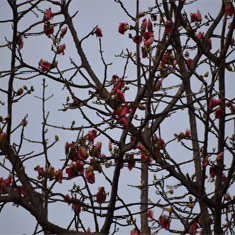| Binomial |
Bombax ceiba L.
|
| Family |
Malvaceae
|
| Tamil Name |
Mul Elavu (முள் இலவு)
|
| Tree |
Tall deciduous with a spreading crown; trunk straight, cylindrical with prominent buttresses and armed with numerous conical prickles. Main branches radiates horizontally from the trunk and more or less whorled.
|
| Bark |
Grey mottled with white and shallow longitudinal fissures.
|
| Flowers |
Large, dark crimson, rich in nectar. sweet scented with campanulate calyx and fleshy recurved petals.
|
| Fruits |
A woody capsule, cylindrical enclosing seeds covered in silky fibre.
|
| Flowering & Fruiting Period |
January to April
|
| Pollinators |
Bees, Birds and Bats |
| Country of origin |
Tropical Asia
|
| About the tree |
The flower buds and the calyx of flowers that are not in full bloom are cooked and eaten as a vegetable. Locally known as "Marathi Moggu,” these flowers buds are not only used as a spice in the regional cuisines of Southern India but is also used in herbal medicine. The bark is employed against cholera and a decoction of the shoots can be used to treat ulcers of the palate. Bombax ceiba plays an integral part in Cantonese culture in which it is literally known as “the cotton-tree flower.” It is the official flower of Guangzhou, the capital of Guangdong Province in southern China and is also used as the trademark of the Guangzhou-based China Southern Airlines.
|

